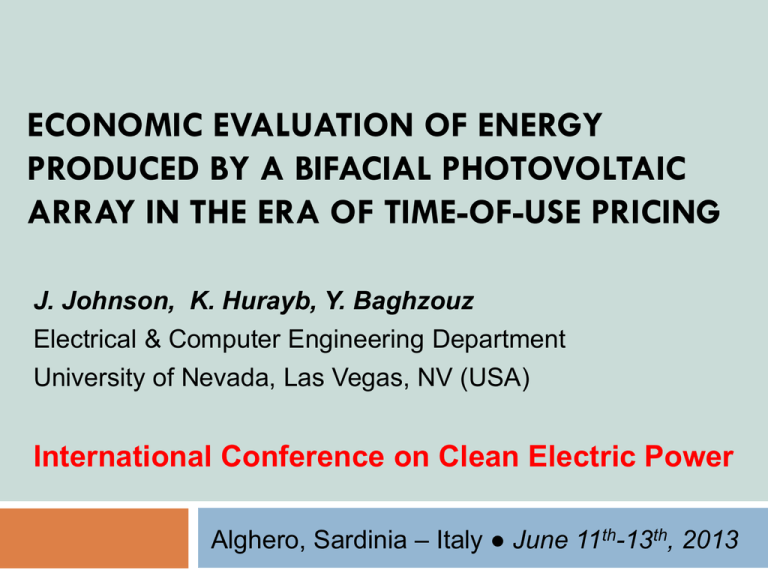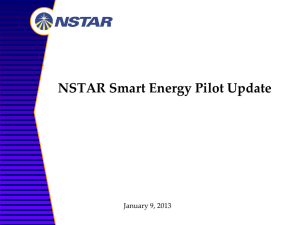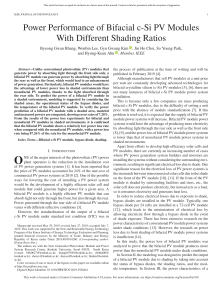
ECONOMIC EVALUATION OF ENERGY
PRODUCED BY A BIFACIAL PHOTOVOLTAIC
ARRAY IN THE ERA OF TIME-OF-USE PRICING
J. Johnson, K. Hurayb, Y. Baghzouz
Electrical & Computer Engineering Department
University of Nevada, Las Vegas, NV (USA)
International Conference on Clean Electric Power
Alghero, Sardinia – Italy ● June 11th-13th, 2013
Overview
Background/Introduction
Bifacial-Photovoltaic Power System Electrical
Characteristics.
Bifacial PV Power Generation Curve under
Different Orientations
Local Utility Load Characteristics
Local Utility Tariffs
Bifacial PV Performance under Different
Orientations
Economic Analysis
Conclusions
Introduction
Bifacial photovoltaic modules are designed to
produce power from light striking their front
as well as light incident on their rear side.
Introduction
Bifacial modules are often installed as sound barriers in fenceintegrated systems in motorways and railways. Other applications
include architectural awnings, partial patio and parking lot covers.
Bifacial PV panels are typically two to 3 times more expensive than
their mono-facial counterparts because of their “added ornamental
value” that allows some of the light to pass though, thus resulting in
a pleasing environment.
Introduction
With the Time-Of-Use (TOU) pricing of electricity becoming
an option to electricity customers, a bi-facial array is
expected to provide an advantage over conventional monofacial arrays as it receives more sunlight .
This article analyzes the performance of a 1 kW, gridconnected, bifacial PV array that is installed on the roof of
a local building over a one-year period. Two orientations
are considered:
West orientation with 90o tilt angle (vertical)
South orientation with 30o tilt angle (equal to latitude angle)
Description of Bifacial PV Array
Array Composition: 5 series
bifacial PV modules.
Module Model: Sanyo HIP-195DA3
Array Electrical Characteristics:
Peak Power: Pmax = 975 W,
Voltage at Pmax: Vm = 275 V,
Current at Pmax: Im = 3.5 A,
Open Circuit Voltage: Voc = 343 V,
Short circuit Current: Isc = 3.73 A,
Power Temp. Coef: TP=-0.35%/oC,
Module Efficiency: η =16.1%.
What is the efficiency of the back side?
The figure below shows the measured power-voltage
curve of each panel side (with the back covered).
The back side is nearly 15% less efficient than the front side of
the panel.
Test Conditions:
Solar irradiance: 950 W/m2
Cell operating temp: 57o C
Circuit Model
Circuit parameter values (best fit):
IL
= 4.45 A,
Io = 1 x 10-10 A,
Rs = 12 mΩ,
Rsh = 6 Ω.
Bifacial PV Power Generation
Orientation: Vertical East/West
Mismatch due to
shade of frame
Bifacial PV Power Generation
Orientation: South with 30o tilt
Utility Load Characteristics
The load is dominated by summer (June - September) and
winter (November - April) patterns, with May and October
being the transition months.
Utility Load Characteristics
The peak demand period is defined from 1:00 pm to 7:00
pm during the four summer months.
Utility Tariffs
Historically, residential customers are charged a fixed rate of
$0.113/kWh for the electric energy consumed throughout the year.
More recently, the company installed an Advanced Metering
Infrastructure (AMI) which allowed it to provide variable rates that
depend on time.
The Time-Of-Use (TOU) rate rewards the customer for reducing the
consumption during the peak summer period.
Current TOU rates for single-family homes are as follows:
During peak demand period (1:00 pm – 7:00 pm), 6/ - 9/30:
$0.329/kWh.
During summer off-peak period (7:00 pm – 1:00 pm), 6/1 - 9/30:
$0.071/kWh.
During rest of the time of the year, 10/1 - 5/31: $0.049/kWh.
Utility Tariffs
Note that relative to the flat standard rate of
$0.113/kWh, the TOU rate is
Increased by nearly 300% during peak demand period:
720 hrs or 8% of the time,
Reduced by nearly 37% during off-peak summer hours:
2,160 hrs or 26% of the time,
Reduced by nearly 57% during the rest of the year:
5,760 hrs or 66% of the time.
Bifacial PV Power Generation
Comparison of two orientations during peak demand
The vertical East-West orientation generates significantly more
energy during the latter half, but less energy during the first half of
the peak demand period when compared to the south-facing
orientation.
Bifacial PV Power Generation
Comparison of two orientations during the summer months
The vertical east/west orientation generates more energy in June
& July, but less energy in August and September.
Bifacial PV Power Generation
Comparison of two orientations during entire year
The South-facing orientation outperforms the vertical East/West
orientation except during the months of May, June and July.
ANNUAL ENERGY COST PRODUCED BY PV ARRAY
ARRAY ORIENTATION
COST
(FIXED RATE)
COST
(TOU RATE)
South with 30o Tilt all Year
$259.22
$237.43
West with 90o Tilt all Year
$226.90
$220.85
South with 30o Tilt (Oct –
May), and West with 90o
Tilt (June – Sept.)
$257.30
$234.03
Conclusions
The vertical East/West orientation produces significantly more
energy during the late afternoon hours of the summer months, but
less energy during the early afternoon hours.
The total amount of energy produced by the vertical East/West
orientation during the 4 summer months in nearly the same as that
of south-facing orientation.
For obvious reasons, the south-facing orientation produces
significantly more energy during the winter and shoulder months.
The fixed South-facing orientation performs best under both fixed
and TOU energy rates.
A slight improvement can be made by re-orienting the array to a
vertical East/West orientation during the months of May, June and July,
but this is not worth the effort.
The recessed frame design caused significant shading in the late
morning hours, thus not suitable for vertical east-west orientation.
Acknowledgement
The work presented in this paper is sponsored
by the National Renewable Energy Laboratory
(NREL), Golden, CO, (USA).
Questions and Comments?










